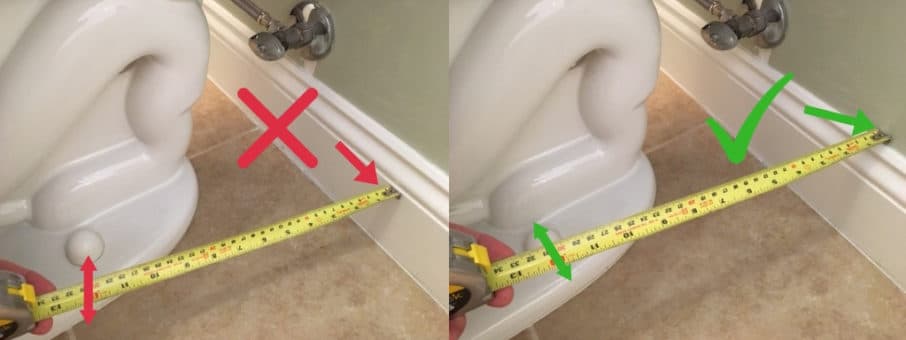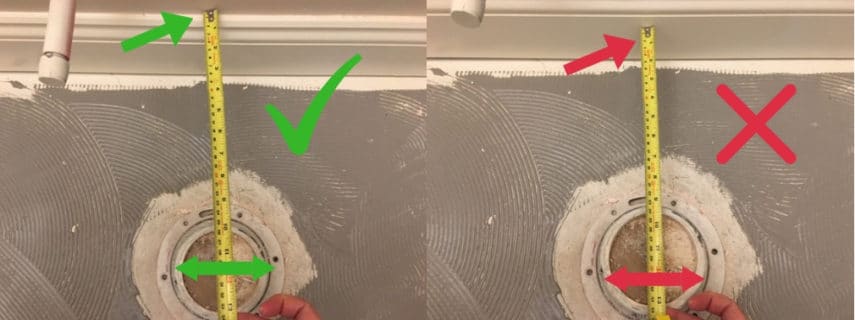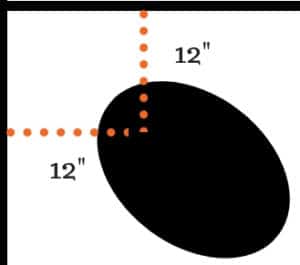You’ve decided to get a new toilet. Maybe you’re upgrading from the decade’s old crapper you have in your bathroom. Or maybe you’re remodeling or building a new house.
A walk down the bathroom aisle at your local home improvement store will highlight the latest and greatest toilets, as well an Internet search that tells you about water efficiency and superior flushing power.
But before you decide on a toilet, you’ll need to understand a little more about your plumbing. If you’re prepared you’ll know the “rough in” measurement of your plumbing and it will help ensure you choose a toilet that fits!
What exactly is a “rough in” and how do you measure a toilet rough in? In this article, we’ll get to the bottom of it.
I’ll share 4 different methods of measuring your rough in, including 1) Measuring with an existing toilet installed, 2) Measuring on a remodel, 3) Measuring on the foundation of your home (before it’s built), and 4) Measuring for a corner toilet.
I’ll also share the standard size for a toilet rough in (yes, they can be different). Once you know the rough in for your home, making a toilet purchase will be a breeze.
What Is A “Toilet Rough In”
So, what is the “toilet rough in”. The term isn’t exactly self-explanatory so it does take some understanding of toilets and plumbing.
The rough in is a measurement that you need to ensure that your toilet fits snugly against the wall.
If you measure correctly, there will be a few inch gap between the tank and wall (which is important to access the tank).
If your toilet is positioned in the center of the room then the rough in measurement won’t matter, however, most people choose to have the back of their toilet against a wall. If you have a corner toilet, you’ll still measure the rough in (below I’ll share how to measure a corner rough in).
How To Measure Rough In For A New Toilet
Now that you know what a rough in is, I can help you with getting the right measurement. There are a few different ways you can measure and it depends on your situation.
Are you building a house, are you remodeling, or do you need to measure your rough in while the old toilet is still there?
-
Measuring Rough In With Existing Toilet
Most people will need to know their rough in while they’ve still got a toilet attached to the ground. If you can’t see the plumbing in the floor then how can you measure?
Toilet companies have made it easy for us because the bolts that attach the toilet to the flood are set in on the center of our plumbing.

On either side of your toilet, you’ll see two bolts (usually with caps on them). Measure from the center of those caps or bolts to the wall and that measurement is your “rough in”.
Do not measure from the baseboard, instead, measure from the wall (baseboard will reduce your measurement an inch or so).
-
Measuring Rough In On Remodeled Bathroom
If you’re remodeling your bathroom you might have removed the old toilet. In this case, you’ll see a circular opening to a pipe that goes under your house.

You will take your measurement from the center of the pipe to the wall (not the baseboard). Many people make a mistake and measure from the front or back of the pipe – make sure it’s the middle.
-
Measuring Rough In On New House (Foundation)
If you want to get a head start on your furnishings while your house is being built, then you might need to measure the rough in when there’s only a foundation.

In this case, you can measure from the center of your plumbing to the lines marked to show where the wall will be (without marks for the wall you won’t be able to measure the rough in).
-
Measuring A Rough In For A Corner Toilet
Measuring for a corner toilet might seem tricky, but it’s just as easy. To do so, you’ll need to take two measurements – distance from the plumbing to each side of the wall (not from the corner).

The measurement from each side of the wall should be the same.
Most Common Mistakes When People Measure The Toilet Rough In
-
Measuring from the baseboard and not from the wall
If you have a baseboard, you’ll want to measure above it so the end of your tape measure is against the wall.
-
Measuring to the beginning or end of the bolt or flange and not the middle
Many people measure to the beginning of the plumbing or to the end and they get confused about their rough in measurement. The rough in should be smack dab in the middle of the pipe.
Standard Toilet Rough In (Common Rough In Sizes)
The standard toilet rough in is 12”. I’d say 80% of toilets have a 12” rough in so don’t be surprised if you do as well.
There are, however, other rough in sizes. 10” and 14” are also possible and you’ll have a smaller selection of toilets that fit those sizes.
If your measurement comes out to 11.5” or 12.5” then don’t worry, it’s likely a 12” rough in.
Conclusion
Getting a new toilet isn’t something we do often. Once or twice in our lives, we build a house or remodel our bathroom, but given that we use our toilet every day of every year, it makes sense that we should change our toilet more often.
When you begin to look at toilet options you’ll read all kinds of details about the toilet. 1 or 2-piece, single or dual flush, water-efficient are all pretty straightforward, right? Rough in size isn’t so straightforward and requires a little more research.
In this article, I shared the 4 ways to measure a toilet rough in. It doesn’t matter whether a toilet is already installed or whether there’s no toilet, you can still get the measurement if you know what you’re doing.
In most cases your rough in measurement will be 12”. There are also 10” and 14” rough ins as well.
I hope this article and the photos help you measure your toilet’s rough in. Let us know in the comments if you have any questions or suggestions. Thanks for visiting Toilet Travels.
